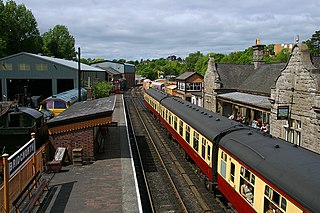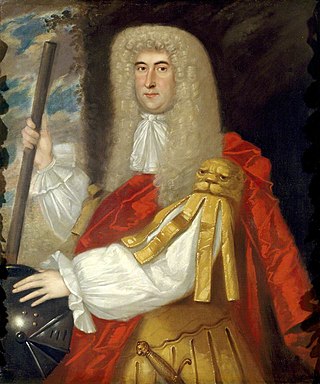
The Severn Valley Railway is a standard gauge heritage railway in Shropshire and Worcestershire, England, named after the company that originally built the railway over which it now operates. The 16-mile (26 km) heritage line runs from Bridgnorth to Kidderminster, following the course of the River Severn along the Severn Valley for much of its route, and crossing the river on the historic Victoria Bridge.

Bridgnorth railway station is a station on the Severn Valley Railway heritage line, serving the Shropshire town of Bridgnorth, England. It is currently the northern terminus of the SVR, home to the main engine shed and has a gift shop, station buffet and licensed refreshment room amongst other facilities.
Bridgnorth was a parliamentary borough in Shropshire which was represented in the House of Commons of England from 1295 until 1707, then in the House of Commons of Great Britain until 1800, and in the House of Commons of the Parliament of the United Kingdom from 1801 until its abolition in 1885.

Linley, later Linley Halt, was a small railway station on the Severn Valley line in Shropshire, England.

There have been two baronetcies created for members of the Whitmore family, one in the Baronetage of England and one in the Baronetage of the United Kingdom. One creation is extinct while the other is extant.

Dudmaston Hall is a 17th-century country house in the care of the National Trust in the Severn Valley, Shropshire, England.

Apley Hall is an English Gothic Revival house located in the parish of Stockton near Bridgnorth, Shropshire. The building was completed in 1811 with adjoining property of 180 acres (0.73 km2) of private parkland beside the River Severn. It was once home to the Whitmore & Foster families. The Hall is a Grade II* listed building claimed as one of the largest in the county of Shropshire.

Thomas Whitmore was an English Whig politician who sat in the House of Commons from 1806 to 1831.
Henry Whitmore was an English Conservative politician who sat in the House of Commons between 1852 and 1870.

Sir Thomas Whitmore, 1st Baronet was an English politician who sat in the House of Commons of England between 1640 and 1644. He supported the Royalist side in the English Civil War.

Sir William Whitmore, 2nd Baronet was an English politician who sat in the House of Commons from 1661 to 1699.

William Wolryche-Whitmore, also known as W. W. Whitmore, was a Shropshire landowner and British Whig politician. He held a seat in the House of Commons from 1820 to 1835, representing first Bridgnorth and later Wolverhampton.

Sir William Whitmore was an English landowner and politician who sat in the House of Commons at various times between 1621 and 1626.
John Bennet was an English landowner and politician who sat in the House of Commons from 1660 to 1663.

John Wolryche (c.1637–1685) was a lawyer and politician of landed gentry background who represented Much Wenlock in the House of Commons of England in two parliaments of Charles II. He was a moderate Whig, opposing the succession of James II but avoiding involvement in conspiracies.

William Orme Foster DL was an English ironmaster, coalmaster and owner of the large industrial firm John Bradley & Co, which he inherited from his uncle, James Foster in 1853. He served as a Liberal MP for South Staffordshire from 1857 until 1868.
Thomas Whitmore, was a British soldier and politician who sat in the House of Commons for 24 years from 1771 to 1795.
John Weaver (1675–1747), of Morville, near Bridgnorth, Shropshire, was a British lawyer and Whig politician who sat in the House of Commons from 1713 to 1734.
St John Charlton of Apley Castle, Shropshire was a Royal Navy officer and politician who sat in the House of Commons from 1725 to 1734.
Sir Thomas Whitmore of Apley, near Bridgnorth, Shropshire, was a British Whig politician who sat in the House of Commons from 1734 to 1754.








